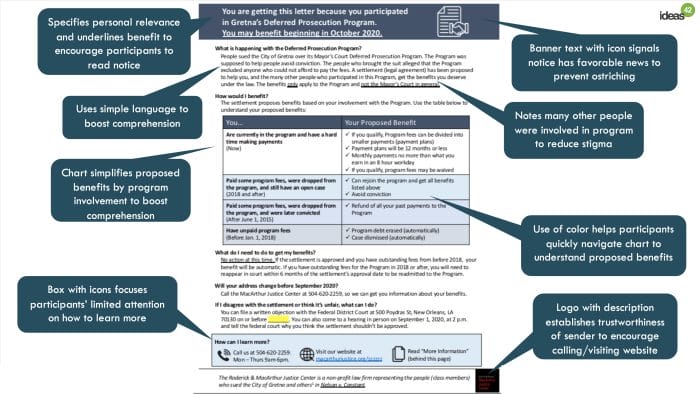Increasing Response Rates for Class Action Lawsuit Communications
HIGHLIGHTS
- Potential litigants often do not act upon the class action lawsuit letters they receive due to a misunderstanding of the personal relevance and benefits of the lawsuit on the recipient.
- By using behavioral science principles to redesign these letters, more potential litigants are likely to read, understand, and respond to the class action lawsuit communications they receive.
The Challenge
Letters regarding class action lawsuits are often tossed aside due to their excessive length and use of legalese jargon. But these letters often contain information vital to people understanding their rights and benefits from a settlement. The MacArthur Justice Center knew of this challenge when they filed a federal class action lawsuit against the City of Gretna, alleging that the city excessively charged for a diversion program litigants could have used to avoid convictions for nonviolent misdemeanor offenses. To help the litigants overcome these barriers, we worked together to design a behaviorally informed notice that people would actually act upon.
Our Approach
We designed the notice to overcome behavioral barriers that may impede people from understanding how the lawsuit could affect their rights. To increase the response rate to the letters, we worked with the MacArthur Justice Center to gain a better understanding of the population receiving them.
Using this deep understanding of the context and leveraging our prior work designing behaviorally informed court communications, we identified the following behavioral barriers that were preventing people from taking action on the class action lawsuit communications they received:
- Ostriching: the tendency to avoid information that we anticipate will be negative or aversive, such as news about a lawsuit or from a court.
- Identity threat: the tendency to feel negatively judged because of a stereotype, like being charged with an infraction or a crime.
- Scarcity/limited attention: when a lack of resources (such as money) fills up our mental bandwidth to the exclusion of other things (like reading and following up on a letter about a lawsuit).
- Hassle factors: inconveniences and/or obstacles that impede the desired behavior.
Results
To account for the identified behavioral barriers and help litigants overcome them, we redesigned the letter to emphasize 1) the settlement applied to the person receiving the letter, 2) the settlement offered specific benefits, and 3) how and when to access those benefits. These elements were bolstered by replacing legal jargon with plain language, using charts to help litigants find the rights that applied to them, and including banners that underscored the personal relevance, benefits, and resources for the litigant.
Behaviorally Designed Class Action Lawsuit Notice
Takeaway
Class action lawsuit communications must be designed for the reader rather than the court process. While class action lawsuits are inherently complex, behaviorally designed communications can boost potential litigants’ comprehension, trust, and, ultimately, willingness to act upon their communications by removing legal jargon and incorporating behaviorally informed design elements.










